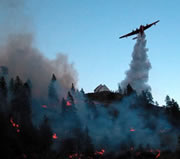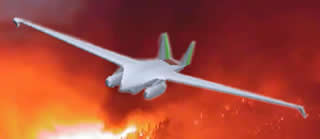
Better to prevent than to cure. For managing forest fires, the maxim means global surveillance. |
Everyone remembers the dramatic fires of the summer of 2003. Nearly 50,000 hectares of Mediterranean forest was destroyed by fire and several people died. Now, it is clear that the prevention of these sorts of fires will necessarily mean better surveillance of the forests during hot dry periods. The earlier the warning of the start of a fire, the easier it is to fight it. Moreover, increased surveillance would also make it possible to identify suspicious vehicles in the vicinity of the seat of a fire and so discourage firesetters. The surveillance of extended zones would require significant human resources and this is why other solutions may be worth looking at. As it happens, drones, pilotless aircraft, seem to be particularly appropriate for a job like this, provided certain constraints are taken into account. |
|
Firstly, they shouldn’t disturb normal air traffic. In this respect, the ideal would be high altitude flight, at 20,000 meters (60,000 feet), above commercial flight paths. But flying a device at these altitudes is complex. Because the air is not very dense then problems of propulsion, lift and evaluation of aerodynamic coefficients arise. These drones would also have to remain at altitude long enough to efficiently monitor the fires. It would seem that a durability of 24 hours (plus time to arrive and return) is appropriate. Finally, they should be able to carry powerful optical and electromagnetic instruments capable both of locating fires and following vehicles in the area. "We are taking part in a multi-disciplinary program, with industrial partners, to define the feasibility of these surveillance drones in terms of aerodynamics, structure, propulsion, payload, and instrumentation which guarantee a level of reliability comparable to that of current commercial aircraft", explains Claude the Tallec, project leader at Onera.
According to the initial results, these drones flying at high altitude should have around a thirty meter wing span and weigh around ten metric tons. They will then have enought space to install various instruments such as optical and electromagnetic detectors operating at various frequencies, in order to distinguish fire from other sources of radiation and to be able to follow vehicles. "The complementarity between the optical imaging and the radar seems to be quite promising", enthuses Claude Le Tallec. Around ten of these drones could monitor a large part of the Mediterreanean basin.
The research program, which will publish its conclusions at the end of 2004, also has to evaluate the cost of such a device and to define other possible applications. "When there is no risk of fire, these drones could be assigned to ocean surveillance, for the detection and prevention of oil dumping", according to Claude Le Tallec. "They could also be used in a communications network where the terrestrial network is destroyed; for example, as the result of an earthquake. Finally, it seems that there may be an increasing need of constant surveillance of parts of the territory, to find, for example, the perpetrators of terrorist attacks." It just remains to win the financial arguments.

The detection of the seats of fires and the localization of arsonists is just one of the potential civil applications of drones.
Cécile Michaut, scientific reporter.
|






